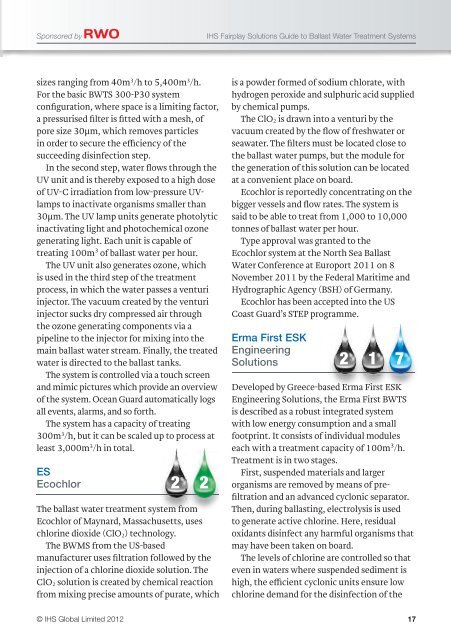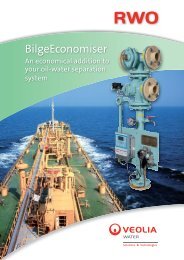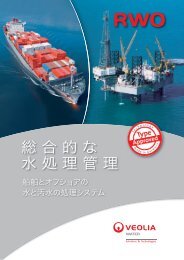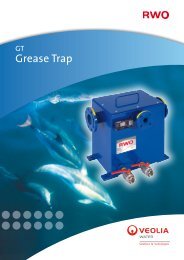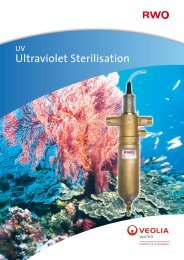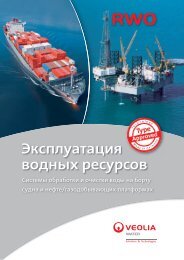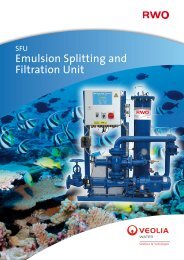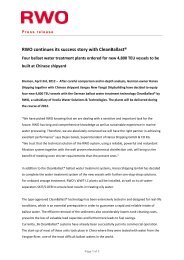the IHS Ballast Water Guide - RWO Marine Water Technology
the IHS Ballast Water Guide - RWO Marine Water Technology
the IHS Ballast Water Guide - RWO Marine Water Technology
You also want an ePaper? Increase the reach of your titles
YUMPU automatically turns print PDFs into web optimized ePapers that Google loves.
Sponsored by <strong>IHS</strong> Fairplay Solutions <strong>Guide</strong> to <strong>Ballast</strong> <strong>Water</strong> Treatment Systems<br />
sizes ranging from 40m 3 /h to 5,400m 3 /h.<br />
For <strong>the</strong> basic BWTS 300-P30 system<br />
configuration, where space is a limiting factor,<br />
a pressurised filter is fitted with a mesh, of<br />
pore size 30µm, which removes particles<br />
in order to secure <strong>the</strong> efficiency of <strong>the</strong><br />
succeeding disinfection step.<br />
In <strong>the</strong> second step, water flows through <strong>the</strong><br />
UV unit and is <strong>the</strong>reby exposed to a high dose<br />
of UV-C irradiation from low-pressure UVlamps<br />
to inactivate organisms smaller than<br />
30µm. The UV lamp units generate photolytic<br />
inactivating light and photochemical ozone<br />
generating light. Each unit is capable of<br />
treating 100m³ of ballast water per hour.<br />
The UV unit also generates ozone, which<br />
is used in <strong>the</strong> third step of <strong>the</strong> treatment<br />
process, in which <strong>the</strong> water passes a venturi<br />
injector. The vacuum created by <strong>the</strong> venturi<br />
injector sucks dry compressed air through<br />
<strong>the</strong> ozone generating components via a<br />
pipeline to <strong>the</strong> injector for mixing into <strong>the</strong><br />
main ballast water stream. Finally, <strong>the</strong> treated<br />
water is directed to <strong>the</strong> ballast tanks.<br />
The system is controlled via a touch screen<br />
and mimic pictures which provide an overview<br />
of <strong>the</strong> system. Ocean Guard automatically logs<br />
all events, alarms, and so forth.<br />
The system has a capacity of treating<br />
300m 3 /h, but it can be scaled up to process at<br />
least 3,000m 3 /h in total.<br />
ES<br />
Ecochlor 2 2<br />
The ballast water treatment system from<br />
Ecochlor of Maynard, Massachusetts, uses<br />
chlorine dioxide (ClO2) technology.<br />
The BWMS from <strong>the</strong> US-based<br />
manufacturer uses filtration followed by <strong>the</strong><br />
injection of a chlorine dioxide solution. The<br />
ClO2 solution is created by chemical reaction<br />
from mixing precise amounts of purate, which<br />
is a powder formed of sodium chlorate, with<br />
hydrogen peroxide and sulphuric acid supplied<br />
by chemical pumps.<br />
The ClO2 is drawn into a venturi by <strong>the</strong><br />
vacuum created by <strong>the</strong> flow of freshwater or<br />
seawater. The filters must be located close to<br />
<strong>the</strong> ballast water pumps, but <strong>the</strong> module for<br />
<strong>the</strong> generation of this solution can be located<br />
at a convenient place on board.<br />
Ecochlor is reportedly concentrating on <strong>the</strong><br />
bigger vessels and flow rates. The system is<br />
said to be able to treat from 1,000 to 10,000<br />
tonnes of ballast water per hour.<br />
Type approval was granted to <strong>the</strong><br />
Ecochlor system at <strong>the</strong> North Sea <strong>Ballast</strong><br />
<strong>Water</strong> Conference at Europort 2011 on 8<br />
November 2011 by <strong>the</strong> Federal Maritime and<br />
Hydrographic Agency (BSH) of Germany.<br />
Ecochlor has been accepted into <strong>the</strong> US<br />
Coast Guard’s STEP programme.<br />
Erma First ESK<br />
Engineering<br />
Solutions 2 1 7<br />
Developed by Greece-based Erma First ESK<br />
Engineering Solutions, <strong>the</strong> Erma First BWTS<br />
is described as a robust integrated system<br />
with low energy consumption and a small<br />
footprint. It consists of individual modules<br />
each with a treatment capacity of 100m³/h.<br />
Treatment is in two stages.<br />
First, suspended materials and larger<br />
organisms are removed by means of prefiltration<br />
and an advanced cyclonic separator.<br />
Then, during ballasting, electrolysis is used<br />
to generate active chlorine. Here, residual<br />
oxidants disinfect any harmful organisms that<br />
may have been taken on board.<br />
The levels of chlorine are controlled so that<br />
even in waters where suspended sediment is<br />
high, <strong>the</strong> efficient cyclonic units ensure low<br />
chlorine demand for <strong>the</strong> disinfection of <strong>the</strong><br />
© <strong>IHS</strong> Global Limited 2012 17<br />
012_037_CorrectedBW1204.indd 17 01/08/2012 15:31:42


